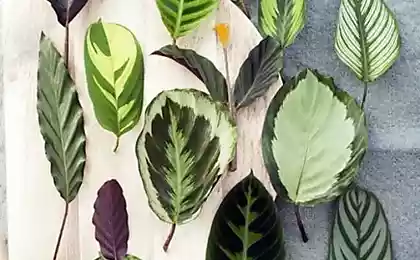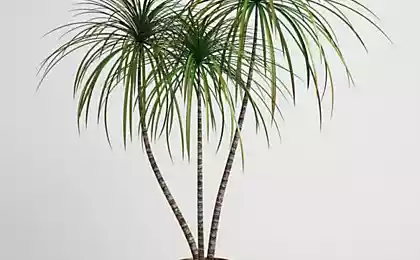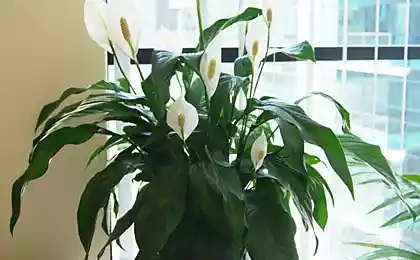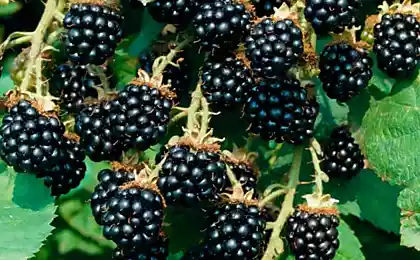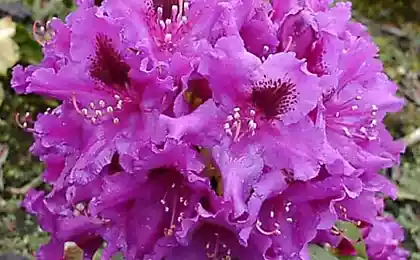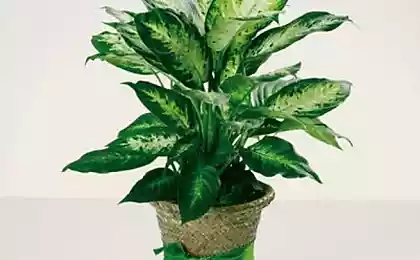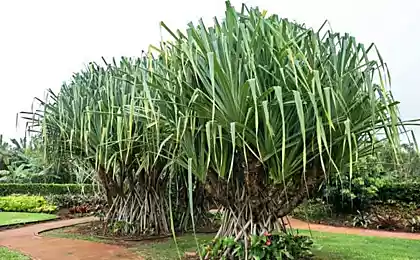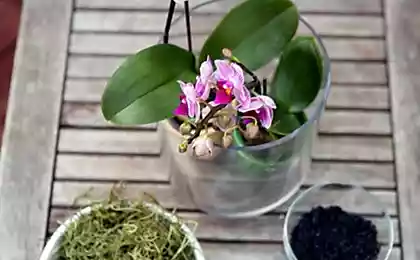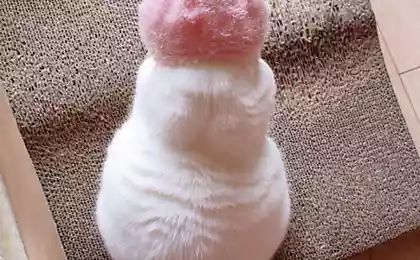582
Elysia chlorotica: half animal and half plant
If you think it can't be – you're wrong. Looks like an insult: "You're a vegetable" takes on a special hue in the light of this material. There are several types of slugs, which have chlorophyll in their body and are able to create food from sunlight.
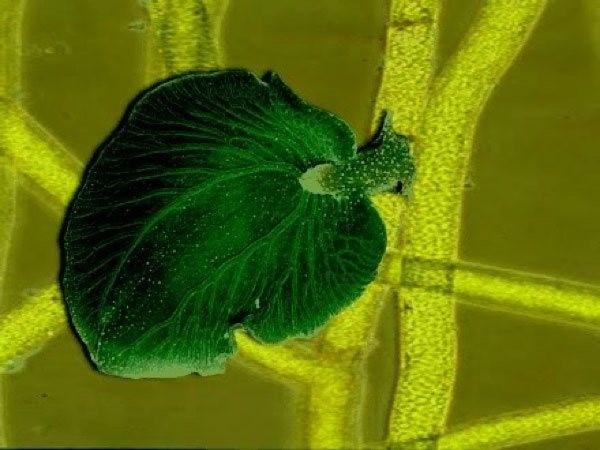
The chlorophyll in these slugs is missing at birth. It is acquired by organisms over time. This happens due to eat large quantities of plants. Only eating here is somewhat different. Instead of traditional digestion, the resulting chlorophyll, the slugs are doing part of their cells. Some slugs actually even able to horizontally transfer DNA of algae in your body. Well, more a matter of technique. You just need to sit in the sun and wait for energy
So what were they called ?
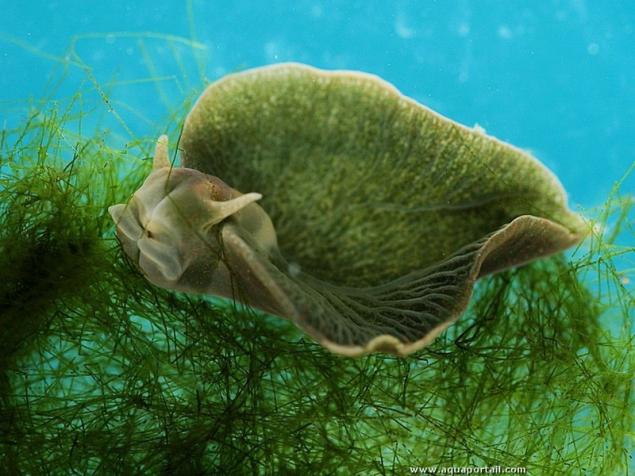
Elysia chlorotica is a species of small slugs belonging to the marine gastropod molluscs. This is the first animal known to scientists, are able, like plants, carry out photosynthesis. Their chloroplasts had not, therefore, to carry out photosynthesis it uses the chloroplasts of the algae Vaucheria litorea, which eats. The slug gene encodes some proteins essential to chloroplasts for photosynthesis.
Adults Elysia chlorotica usually have a bright green coloration due to the presence in the cells of the chloroplasts of the Alga Vaucheria litorea. Sometimes there are sea slugs reddish or grayish hues, I guess it depends on the amount of chlorophyll in the cells. Young individuals that have not consumed the algae are brown with red spots the color because of the lack of chloroplasts. Sea slugs have large side parapodia, resembling a gown, which can collapse, surrounding their body. In length sometimes up to 60 mm, but their average size is 20-30 mm.
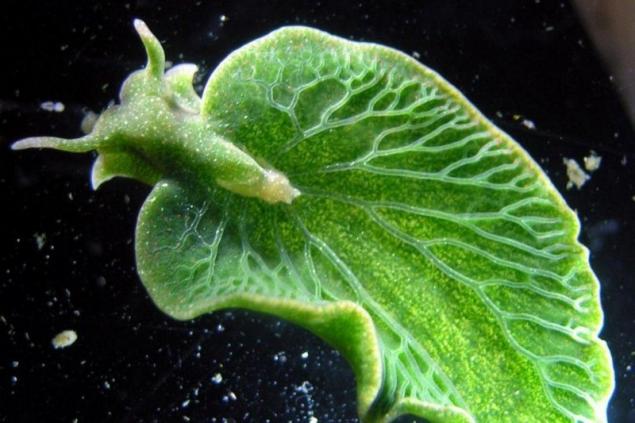
Elysia chlorotica can be found along the Atlantic coast of the United States and Canada. Sea slug lives in salt marshes, backwaters and shallow bays at depths up to 0.5 meters.
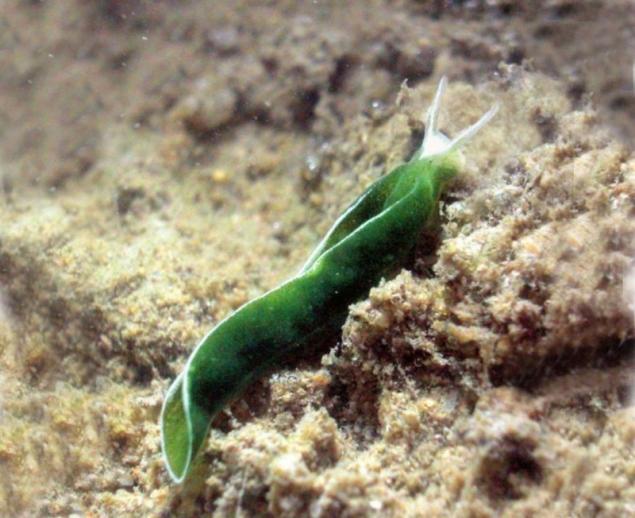
The slug Elysia chlorotica eats the algae Vaucheria litorea. It pierces the sheath cells of their "radula" and drains its contents. Almost all the contents of the cells of the slug digest, but the chloroplasts of the algae leaves intact, assimilating them into its own cells. Accumulation slug of chloroplasts begins immediately following metamorphosis of the larvae into the adult, when it comes to food algae.
Young slugs are brown with red spots, feeding on algae stains them green color is caused by the gradual distribution of chloroplasts in a very extensive digestive tract. First, young slugs feed on the algae continuously, but over time the chloroplasts accumulate, enabling the slug to remain green without food Vaucheria litorea. Moreover, it activates the process of photosynthesis, and the slug goes to the "vegetative" lifestyle, fueled by solar energy.
Assimilated Elysia chlorotica chloroplasts carry out photosynthesis, which allows slime in the period when algae are not available — many months to live at the expense of glucose obtained through photosynthesis.
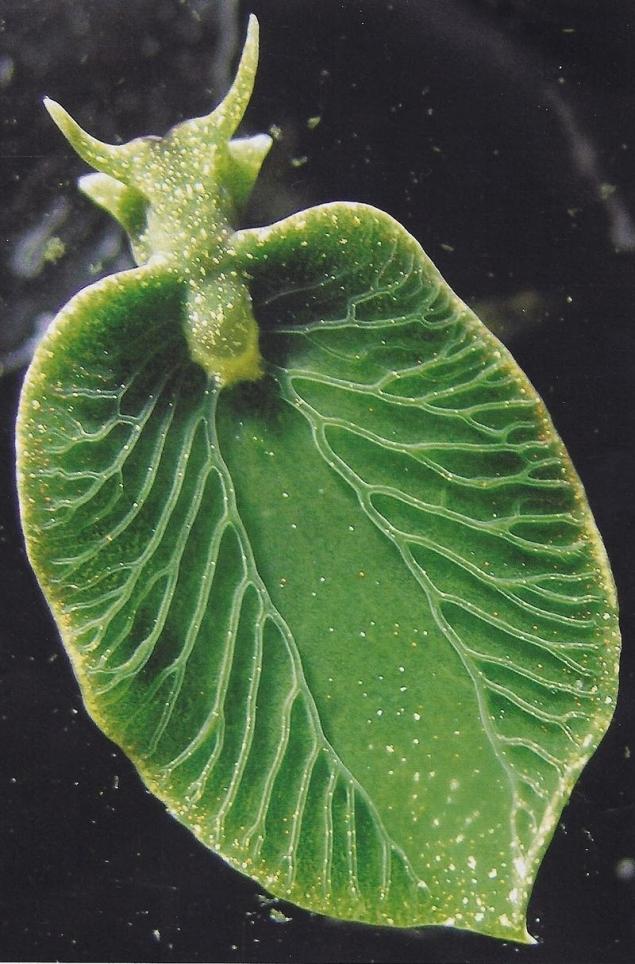
Chloroplasts in the cells of the slug are viable and there are nine to ten months (which is significantly more than possible, skrocki/Alex). But the DNA of chloroplasts encodes only 10 per cent of their proteins. In plants chloroplasts — intracellular organelles — many proteins obtained from the cytoplasm of the cell, these proteins are encoded by the nuclear genome of plant cells. Arose the hypothesis that the genome of Elysia chlorotica must also possess the genes responsible for photosynthesis. In the genome of a slug was discovered a gene that is homologous nuclear genes of algae psbO, encoding a protein of photosystem II. It has been suggested that this gene obtained the slug as the result of horizontal gene transfer. Perhaps Elysia chlorotica nuclear genome contains other genes encoding proteins involved in photosynthesis.
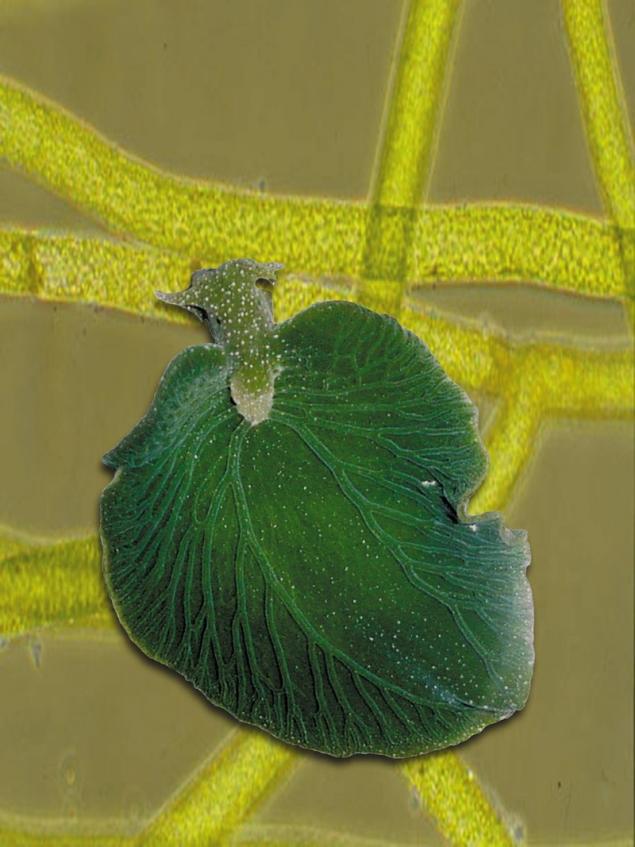
Adults Elysia chlorotica are simultaneous hermaphrodites — each adult animal produces sperm and eggs. The pregnant not common in this species usually occurs cross-mating. After the egg is fertilized sea slug glue them together in a long strand.
The life cycle of a sea slug lasts for nine or ten months, and all adult individuals die annually and synchronously after oviposition. Scientists have found that this "phenomenon of programmed death" by living in the cells of Elysia chlorotica virus.
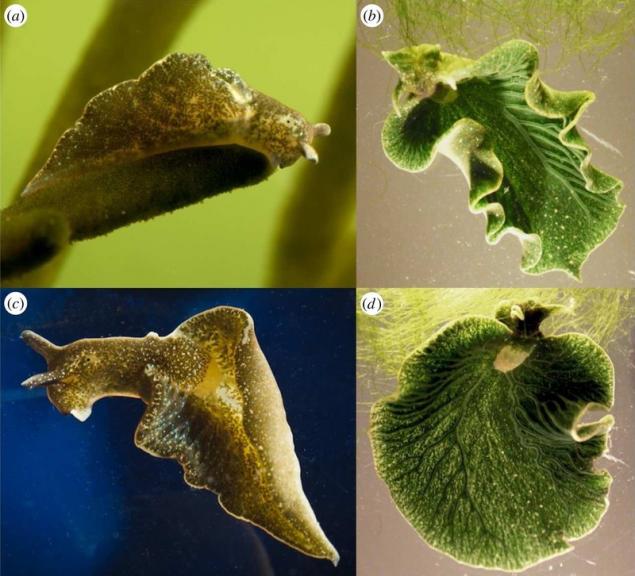
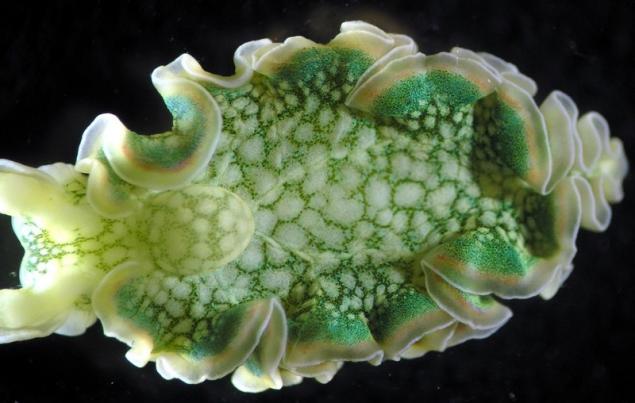
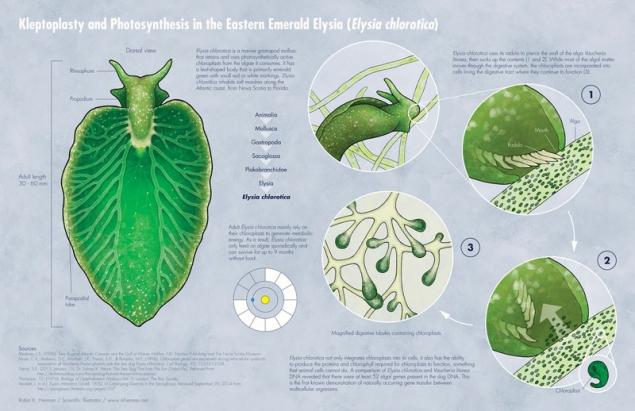
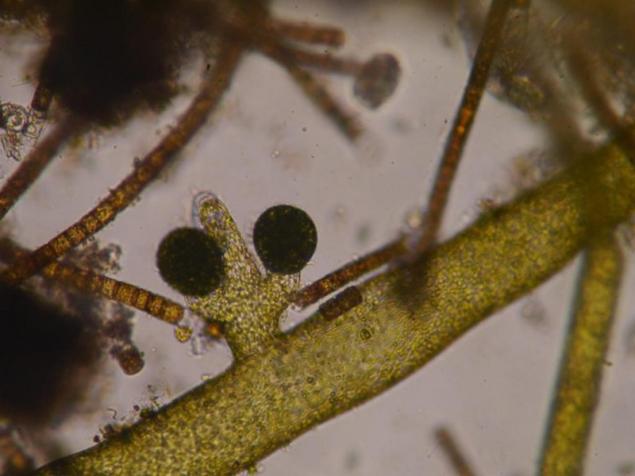
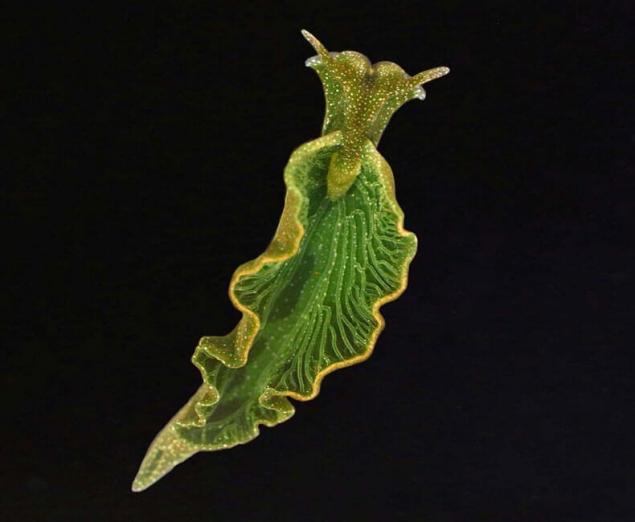
published
P. S. And remember, just changing your mind — together we change the world! ©
Source: masterok.livejournal.com/

The chlorophyll in these slugs is missing at birth. It is acquired by organisms over time. This happens due to eat large quantities of plants. Only eating here is somewhat different. Instead of traditional digestion, the resulting chlorophyll, the slugs are doing part of their cells. Some slugs actually even able to horizontally transfer DNA of algae in your body. Well, more a matter of technique. You just need to sit in the sun and wait for energy
So what were they called ?

Elysia chlorotica is a species of small slugs belonging to the marine gastropod molluscs. This is the first animal known to scientists, are able, like plants, carry out photosynthesis. Their chloroplasts had not, therefore, to carry out photosynthesis it uses the chloroplasts of the algae Vaucheria litorea, which eats. The slug gene encodes some proteins essential to chloroplasts for photosynthesis.
Adults Elysia chlorotica usually have a bright green coloration due to the presence in the cells of the chloroplasts of the Alga Vaucheria litorea. Sometimes there are sea slugs reddish or grayish hues, I guess it depends on the amount of chlorophyll in the cells. Young individuals that have not consumed the algae are brown with red spots the color because of the lack of chloroplasts. Sea slugs have large side parapodia, resembling a gown, which can collapse, surrounding their body. In length sometimes up to 60 mm, but their average size is 20-30 mm.

Elysia chlorotica can be found along the Atlantic coast of the United States and Canada. Sea slug lives in salt marshes, backwaters and shallow bays at depths up to 0.5 meters.

The slug Elysia chlorotica eats the algae Vaucheria litorea. It pierces the sheath cells of their "radula" and drains its contents. Almost all the contents of the cells of the slug digest, but the chloroplasts of the algae leaves intact, assimilating them into its own cells. Accumulation slug of chloroplasts begins immediately following metamorphosis of the larvae into the adult, when it comes to food algae.
Young slugs are brown with red spots, feeding on algae stains them green color is caused by the gradual distribution of chloroplasts in a very extensive digestive tract. First, young slugs feed on the algae continuously, but over time the chloroplasts accumulate, enabling the slug to remain green without food Vaucheria litorea. Moreover, it activates the process of photosynthesis, and the slug goes to the "vegetative" lifestyle, fueled by solar energy.
Assimilated Elysia chlorotica chloroplasts carry out photosynthesis, which allows slime in the period when algae are not available — many months to live at the expense of glucose obtained through photosynthesis.

Chloroplasts in the cells of the slug are viable and there are nine to ten months (which is significantly more than possible, skrocki/Alex). But the DNA of chloroplasts encodes only 10 per cent of their proteins. In plants chloroplasts — intracellular organelles — many proteins obtained from the cytoplasm of the cell, these proteins are encoded by the nuclear genome of plant cells. Arose the hypothesis that the genome of Elysia chlorotica must also possess the genes responsible for photosynthesis. In the genome of a slug was discovered a gene that is homologous nuclear genes of algae psbO, encoding a protein of photosystem II. It has been suggested that this gene obtained the slug as the result of horizontal gene transfer. Perhaps Elysia chlorotica nuclear genome contains other genes encoding proteins involved in photosynthesis.

Adults Elysia chlorotica are simultaneous hermaphrodites — each adult animal produces sperm and eggs. The pregnant not common in this species usually occurs cross-mating. After the egg is fertilized sea slug glue them together in a long strand.
The life cycle of a sea slug lasts for nine or ten months, and all adult individuals die annually and synchronously after oviposition. Scientists have found that this "phenomenon of programmed death" by living in the cells of Elysia chlorotica virus.





published
P. S. And remember, just changing your mind — together we change the world! ©
Source: masterok.livejournal.com/
What are you hiding from us, the employees of McDonald's
The one and only cause of Your constant fatigue
